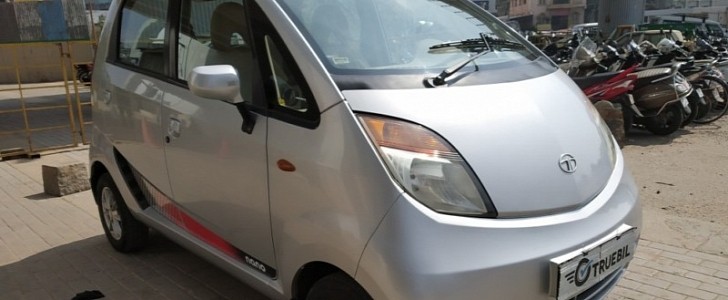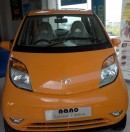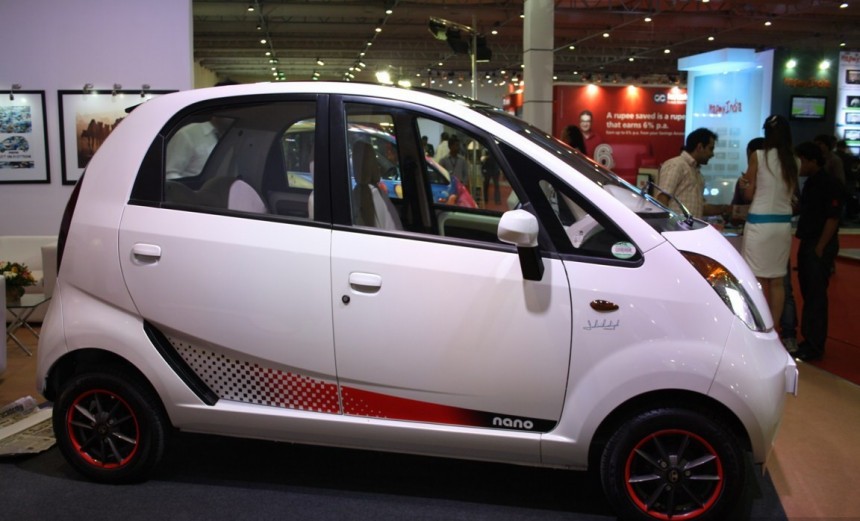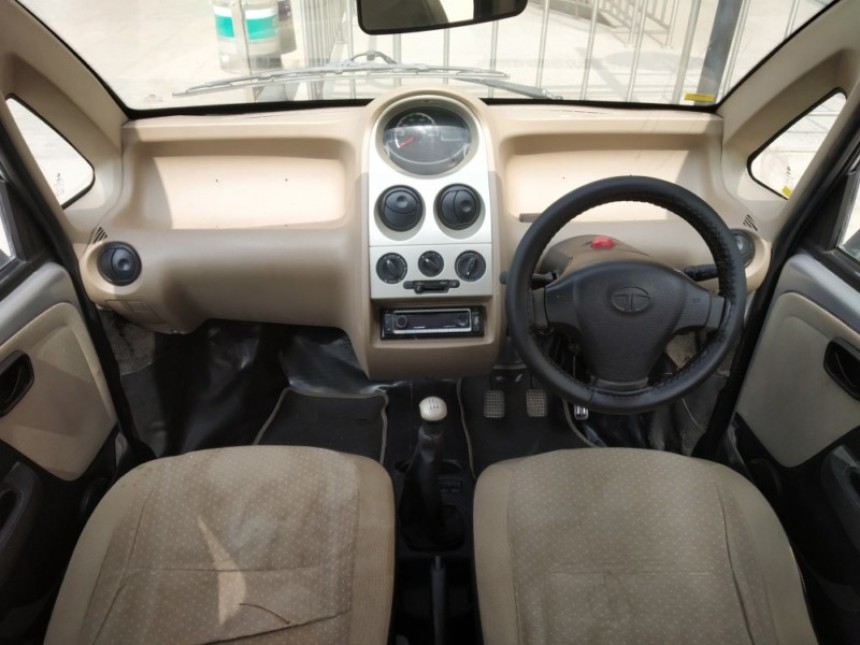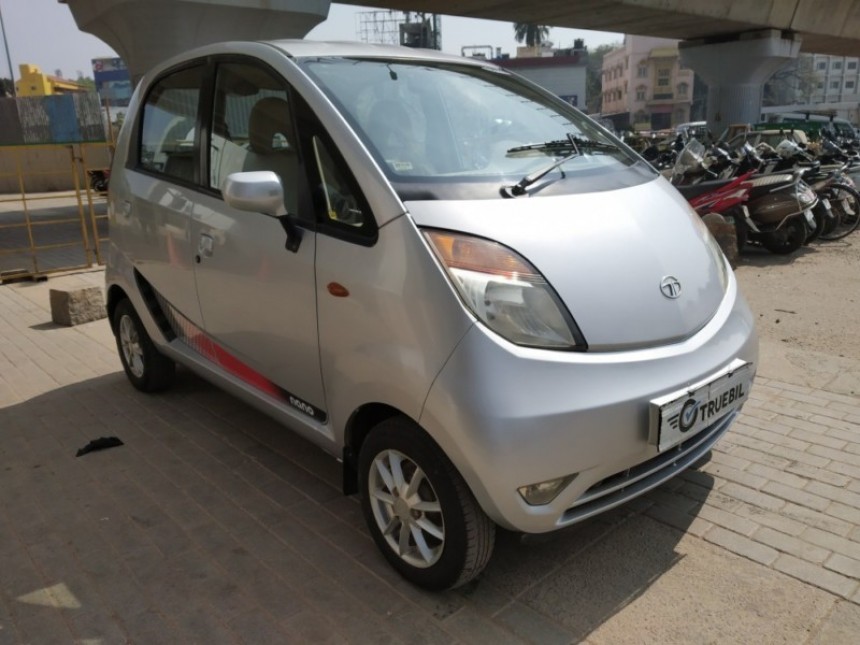The Tata Nano was supposed to be the second coming of the original VW Beetle. Or, at least, that's what the company that sold them was hoping would happen.
Spoiler alert: that didn't wind up happening. Even so, Tata attempted to add a little extra flare every once in a while. As a result, the Nano Special Edition might seem like some poorly thought-out joke.
But it was all too real, and it did at least have a few bells and whistles that the bare basic version we're all used to laughing at didn't have. But first, in case some of you aren't in the loop, here's a quick backstory about the Nano.
Essentially, the Tata Nano was intended to liberate the average Indian motorist from the comically unsafe motor scooter. A brand new car for $3,000 and some change that was, at the very least, better than a crowded city bus. Tata assumed that since the original Beetle served essentially the same purpose that their Nano would be a smash hit.
Tata anticipated sales of 200,000 or more per year. But safe to say, the level of acceptance people have for absurdly cheap cars has risen over the year. Even in places arbitrarily classified by world leaders as "still developing," whatever that means. But even by the cheapest cheapskate's idea of frugality, the lengths Tata went to in order to save money are astonishing.
The Nano's paper-thin doors had no detents in them, meaning that they flopped around like fish fins when not firmly in the closed position. At first, the base Nano's wheels used three lug-nuts instead of four. As if to make the Mitsubishi Mirage feel better about itself. Oh, and the rear glass didn't even open, thus making a hatchback. You just got a space where the hatch handle should be. Neither is there a passenger-side wing mirror, or any HVAC whatsoever, at least in early base Nanos.
So you might be inclined to take the term "special edition" with a grain of salt, if not the whole salt lick when it comes to the Nano. Especially if you're familiar with the behemoth vehicles that Western Europeans and North Americans like to drive around in. Gigantic and fully loaded as they can be at times.
But in the context of an exploding economic superpower of 1.2 billion people ready to rocket onto the world stage while riding a wave of newfound middle-class money, a special edition Nano should at least have some street cred. Only available in the top-of-the-line LX variant in the 2012 and 2013 model year, there were more creature comforts on offer than the base Nano.
At least more so than the poverty-spec base model. Photos from the period seem to indicate a glossy orange paint color as standard with the Nano special edition. We must admit, the Nano-branded digital graphic decal is quite reminiscent of some JDM decal sets from old Hondas and Mitsubishis, a genuinely nice contact.
In fact, a pallet of six different limited edition colors was offered for the Nano Special Edition. It was of a quality that was visibly much more vibrant and high quality compared to what was on offer on the lower-end Nanos. The same thin sheet steel that goes into every Nano finds itself familiarly at home with the special edition.
It may have seatbelts and possibly airbags, but the prospects of hitting so much as a tuk-tuk scooter in one of these are pretty frightening. Equally frightening is the 30-second or so zero to 60 miles per hour time. Safe to say, Interstate 80 is not a place for this car to be traveling.
Thankfully, it doesn't have to. The Blaupunkt stereo system found only in the special edition is sure to make the driving experience at least somewhat more luxurious than had it only had its single-overhead-cam, two-cylinder engine in the rear of every Indian Domestic Market model as a soundtrack.
Some European-Market prototypes were showcased using three-cylinder engines instead were a bridge too far for the Special Edition. Alas, it would have to settle with the smaller of the two motors. At the very least, the twelve-inch alloys on offer with the Special Edition Nano would look pretty slick if not for being so puny. Seriously, they make a 93 Honda Civic's 14" steelies look like Donk wheels.
It's very easy to look at the Nano Special Edition and oddly find it even more pathetic than the base car. At least the most bare-bones Nano never even attempted to persuade people that it had any sporting credentials. But that's a bit of a glass-half-empty kind of perspective, is it not?
If you break the Nano down into its humble intentions and the litany of quirky creature comforts that it does have, suddenly you have something of a perennial underdog or car of the people on your hands. The Nano never sold anywhere near as many units as Tata hoped it would.
But if nothing else, it showcased the emerging Indian automotive sector in a manner it never had before. Today, India is one of the Eastern Hemisphere's most prolific automaking nations. A status achieved primarily in the decade between 2008 and 2018 that the Nano was on sale.
Never before had the world been quite so captivated by a car that was met with such indifference in its home country. But the byproduct of this phenomenon is positively profound. In that vein, the Nano was nothing short of historical success.
Check back for more from Limited Edition Month here on autoevolution.
But it was all too real, and it did at least have a few bells and whistles that the bare basic version we're all used to laughing at didn't have. But first, in case some of you aren't in the loop, here's a quick backstory about the Nano.
Essentially, the Tata Nano was intended to liberate the average Indian motorist from the comically unsafe motor scooter. A brand new car for $3,000 and some change that was, at the very least, better than a crowded city bus. Tata assumed that since the original Beetle served essentially the same purpose that their Nano would be a smash hit.
Tata anticipated sales of 200,000 or more per year. But safe to say, the level of acceptance people have for absurdly cheap cars has risen over the year. Even in places arbitrarily classified by world leaders as "still developing," whatever that means. But even by the cheapest cheapskate's idea of frugality, the lengths Tata went to in order to save money are astonishing.
So you might be inclined to take the term "special edition" with a grain of salt, if not the whole salt lick when it comes to the Nano. Especially if you're familiar with the behemoth vehicles that Western Europeans and North Americans like to drive around in. Gigantic and fully loaded as they can be at times.
But in the context of an exploding economic superpower of 1.2 billion people ready to rocket onto the world stage while riding a wave of newfound middle-class money, a special edition Nano should at least have some street cred. Only available in the top-of-the-line LX variant in the 2012 and 2013 model year, there were more creature comforts on offer than the base Nano.
At least more so than the poverty-spec base model. Photos from the period seem to indicate a glossy orange paint color as standard with the Nano special edition. We must admit, the Nano-branded digital graphic decal is quite reminiscent of some JDM decal sets from old Hondas and Mitsubishis, a genuinely nice contact.
In fact, a pallet of six different limited edition colors was offered for the Nano Special Edition. It was of a quality that was visibly much more vibrant and high quality compared to what was on offer on the lower-end Nanos. The same thin sheet steel that goes into every Nano finds itself familiarly at home with the special edition.
It may have seatbelts and possibly airbags, but the prospects of hitting so much as a tuk-tuk scooter in one of these are pretty frightening. Equally frightening is the 30-second or so zero to 60 miles per hour time. Safe to say, Interstate 80 is not a place for this car to be traveling.
Thankfully, it doesn't have to. The Blaupunkt stereo system found only in the special edition is sure to make the driving experience at least somewhat more luxurious than had it only had its single-overhead-cam, two-cylinder engine in the rear of every Indian Domestic Market model as a soundtrack.
Some European-Market prototypes were showcased using three-cylinder engines instead were a bridge too far for the Special Edition. Alas, it would have to settle with the smaller of the two motors. At the very least, the twelve-inch alloys on offer with the Special Edition Nano would look pretty slick if not for being so puny. Seriously, they make a 93 Honda Civic's 14" steelies look like Donk wheels.
If you break the Nano down into its humble intentions and the litany of quirky creature comforts that it does have, suddenly you have something of a perennial underdog or car of the people on your hands. The Nano never sold anywhere near as many units as Tata hoped it would.
But if nothing else, it showcased the emerging Indian automotive sector in a manner it never had before. Today, India is one of the Eastern Hemisphere's most prolific automaking nations. A status achieved primarily in the decade between 2008 and 2018 that the Nano was on sale.
Never before had the world been quite so captivated by a car that was met with such indifference in its home country. But the byproduct of this phenomenon is positively profound. In that vein, the Nano was nothing short of historical success.
